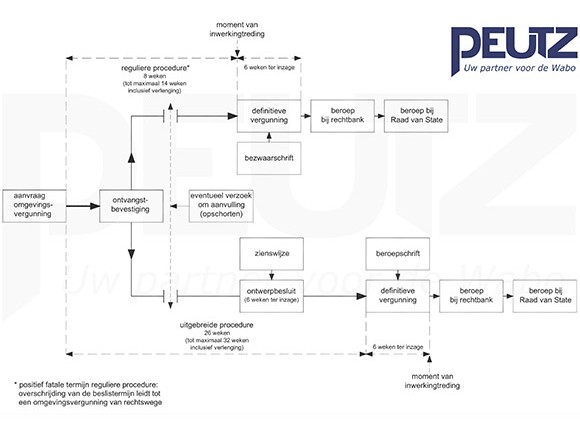
Do you have plans to renovate your company premises, alter your processing systems or build an extension? Or perhaps you’re considering a new-build project at a completely different location? Needless to say, once you’ve made the decision to put your plans into action, you want the subsequent procedures to move as quickly as possible. But how can you get the local authorities on your side?
All kinds of permits are necessary for renovation, extension and new-build activities. The application process can be arduous because there is often a maze of red tape to navigate. However, you often have more influence over the process than you might initially realise. In order to put your plans into action quickly, it is important to have insight into the lead times associated with the various permit application procedures. It can also be useful to know which choices and decisions can affect them.
When processing a permit application, the authority makes a distinction between a regular preparatory procedure and an extended one. Examples of a regular preparatory procedure include a building permit or a small deviation from the zoning plan. An extended preparatory procedure can apply in the case of a significant deviation from the zoning plan, for instance, or an application for an environmental permit. The illustration shows the lead times for the procedures and the relevant steps to be completed. Prepare an overview of the possibilities beforehand; the right approach can save you a lot of time. For example, consider a (preliminary) meeting and good consultation with the relevant authority. That can help to shorten the waiting times somewhat in certain cases, so that you can get the building work underway sooner.
The zoning plan generally determines both how the site may be used and the construction opportunities. What should you do if your plans deviate from the zoning plan? Don’t worry. Even in such cases, there are ways of securing a permit quickly and smartly. For example, it can sometimes be enough to apply for a permit for the construction aspect, possibly combined with an application for a permit to deviate from the zoning plan (8 weeks with a possible 6-week extension). In the case of major deviations from the existing zoning plan, it is possible to apply for a small amendment (‘postzegelplan’. Procedure lead time: approx. 26 weeks). Besides that, there is the opportunity to deviate from the zoning plan via an extended procedure. The advantage of a zoning plan is that you can claim (more) scope for future developments, whereas an environmental permit often only relates to a specific project.
When applying for this type of permit, it is relevant whether your company’s facility will be in the A, B or C category of the Environmental Management Act (Activities Directive), which is determined by the Dutch environmental law (Bor). Companies in the food industry fall into the B or C category. Category B facilities must comply with the general regulations in the Activities Directive. For this type of facility, an announcement of the setting up or changing of a company suffices (4 weeks before occupancy). For category C facilities it is mandatory to apply for an environmental permit. However, the Dutch government is increasingly moving towards letting facilities comply with the general rules (category B). For example, an amendment to the Activities Directive on 1 January 2013 means that many food industry companies no longer have to apply for an environmental permit. If you are not familiar with these regulations, it can be wise to prepare an overview of the relevant rules for your company or enlist expert help so that you know exactly what is expected of you.
The local municipality tends to be your main point of contact when applying for permits, although the scope of your activities may also mean that the decision will be made at provincial level. In the case of an announcement (category B facilities) it can be sufficient to describe the activities. An acoustic study may have to be conducted in some cases. In the case of a permit application (category C facilities), the environmental impact of the activities is examined in more detail. This includes consideration of aspects such as noise, smells, air quality, storage of hazardous substances, external safety, soil protection, etc.

In addition to the aspects mentioned above, legislation such as the Water Act (e.g. discharge of process water) and the Nature Protection Law (nitrogen deposits, flora and fauna) can also be relevant in the permit application procedure. Before the building becomes occupied, it may also be necessary to issue an occupancy notification.
Source: Foto hand: © Imagine Photographer/Shutterstock.com